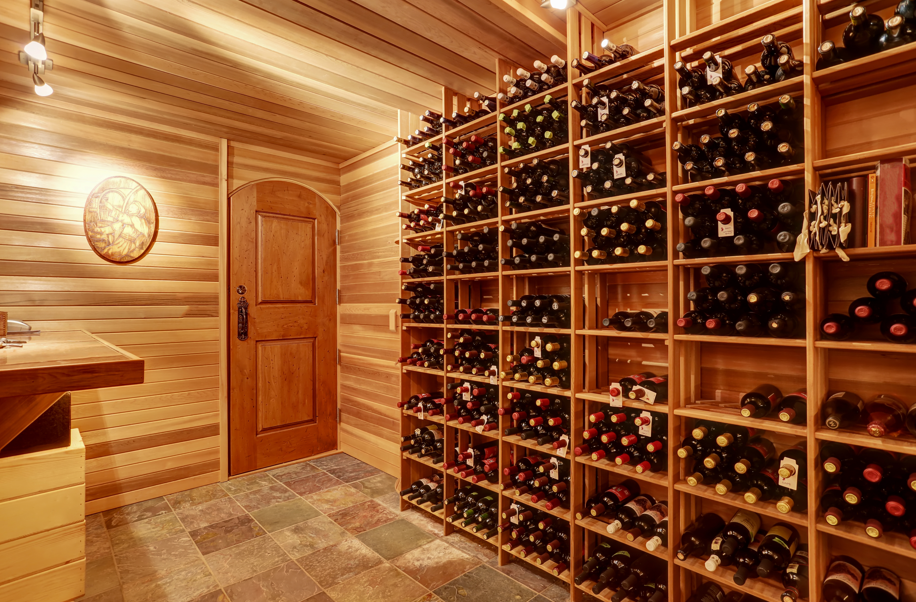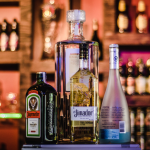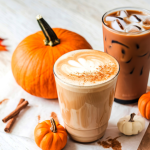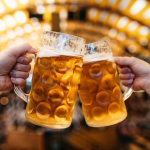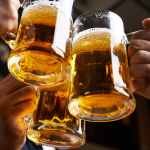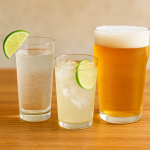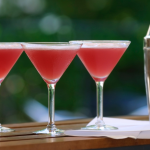Storing and preserving wine is more than just putting bottles on a shelf. For wine lovers, it’s about making sure each bottle stays fresh and tastes great when opened. This guide will help you learn the best ways to store and preserve your wine, whether it’s a fancy red or a simple white.
Key Takeaways
- Keep wine at a steady, cool temperature to maintain its quality.
- Humidity is important to prevent corks from drying out and spoiling the wine.
- Store wine bottles on their sides to keep the cork moist.
- Use wine fridges, racks, or professional cellars for the best storage solutions.
- Once opened, wine should be re-corked and stored in the fridge to stay fresh.
Understanding the Basics of Wine Storage
Learning how to store wine is something everyone who enjoys wine should learn about to some degree. There are the basics of wine storage. Those basics include wine storage temperatures, specifics about the light in the room, and the humidity. If you’re looking into becoming an in-house sommelier or getting a wine certification, those basics are something you’ll already be familiar with. Those general rules around how to store wine apply to wine from the best wineries worldwide to the best wines of 2023. These upcoming six key factors of wine storage for wine enthusiasts go beyond the basics. They’re about more than the aspects of wine storage covering wine security–to avoid bottle shock. These are about aesthetics and appreciation. While your wine storage needs to be secure and regulated for wine preservation, it also needs to be as enjoyable as the wine itself.
Choosing the Right Storage Solutions
Wine Fridges and Coolers
Wine fridges and coolers are excellent for maintaining the ideal temperature for your wine collection. These appliances come with features like dual temperature zones, which allow you to store red and white wines at their respective optimal temperatures. Additionally, many models have UV-protected glass doors to minimize light exposure, ensuring your wine remains in perfect condition.
Wine Racks and Shelving
Investing in wine racks is a simple yet effective way to store your wines. Wine racks are designed to hold bottles in a horizontal position, which is essential for keeping corks moist. This prevents air from entering the bottle and spoiling the wine. Wine racks come in various sizes and designs, making it easy to find one that fits your space and aesthetic preferences.
Professional Wine Cellars
For serious collectors, a professional wine cellar offers the ultimate storage solution. These cellars provide a climate-controlled environment, ensuring that your wine ages gracefully. They also offer high-security measures and insurance options to protect your investment. While setting up a wine cellar requires a significant investment, the benefits of having a dedicated space for your collection are unparalleled.
When choosing a storage solution, consider the size of your collection, your budget, and your personal preferences. Each option offers unique benefits, from the convenience of wine fridges to the security of professional wine cellars.
Best Practices for Storing Different Types of Wine
Red Wines
Red wines are best stored at temperatures between 55°F and 65°F. Keeping them in a cool, dark place helps maintain their flavor and aroma. It’s also important to store red wines on their sides to keep the cork moist, which prevents air from entering the bottle and spoiling the wine.
White Wines
White wines should be stored at slightly cooler temperatures, ideally between 45°F and 50°F. Like red wines, they should be kept away from light and stored on their sides. This helps preserve their crisp and refreshing qualities.
Sparkling Wines
Sparkling wines, including Champagne, need to be stored at even cooler temperatures, around 40°F to 50°F. They should also be kept in a dark place and stored on their sides. This ensures the bubbles remain intact and the wine stays fresh.
Proper storage of different types of wine ensures that each bottle retains its unique characteristics and provides the best possible drinking experience.
Techniques for Preserving Opened Bottles
Re-corking and Vacuum Sealing
Mastering wine preservation can be as simple as re-corking the bottle right after pouring your glass. This helps keep the wine’s flavor intact by minimizing its exposure to air. If the original cork is damaged, consider using a wine stopper. For an even better seal, vacuum sealing systems can remove air from the bottle, extending the wine’s freshness for a few more days.
Using Wine Preservation Systems
Modern wine preservation systems, like gas-based solutions, replace the air in the bottle with inert gases such as argon or nitrogen. This creates a protective layer over the wine, preventing oxidation and keeping the wine fresh for a longer period. These systems are especially useful for preserving high-quality wines.
Refrigeration Tips
Contrary to popular belief, both red and white wines should be stored in the refrigerator after being opened. The cool temperature slows down the oxidation process, helping to maintain the wine’s flavor. Even with proper preservation, most wines should be consumed within a few days of opening.
Preserving opened bottles isn’t just for fancy restaurants or connoisseurs – it’s an essential part of enjoying good wine at home too.
Common Mistakes to Avoid in Wine Storage
Temperature Fluctuations
One of the biggest mistakes in wine storage is allowing temperature fluctuations. Wine should be kept at a stable temperature, ideally around 55°F. Rapid changes can cause the wine to expand and contract, which might push the cork out or cause seepage. This can lead to oxidation and spoil the wine.
Improper Positioning
Storing wine bottles upright for long periods can dry out the cork, allowing air to seep in and oxidize the wine. It’s best to store wine bottles on their side to keep the cork moist. This is especially important for wines with natural corks.
Neglecting Humidity Control
Humidity levels are crucial for wine storage. Too little humidity can dry out the cork, while too much can promote mold growth. Aim for a humidity level between 50% and 80%. Using a humidity control device can help maintain the right balance.
Consistency is key: Keeping a stable environment for your wine will ensure it ages gracefully and maintains its quality.
Essential Accessories for Wine Preservation
Wine Stoppers and Corks
One of the most basic yet vital accessories for wine preservation is the wine stopper or cork. These tools help keep your wine fresh by preventing air from entering the bottle. A good stopper can extend the life of your wine by several days. Whether it’s red, white, or fortified wine, this accessory will surely help keep your drink from spoiling.
Wine Preservation Kits
Wine preservation kits often include a variety of tools designed to keep your wine in optimal condition. These kits may contain vacuum pumps, gas canisters, and specialized stoppers. Using these tools can significantly reduce oxidation, ensuring that your wine remains fresh and flavorful for longer periods.
Humidity Control Devices
Maintaining the right humidity level is crucial for wine preservation. Humidity control devices, such as hygrometers and humidifiers, help you monitor and adjust the humidity in your wine storage area. This is especially important for wines sealed with natural corks, as they can dry out and shrink if the humidity is too low, allowing air to enter the bottle and spoil the wine.
Investing in the right accessories can make a significant difference in the longevity and quality of your wine collection.
Creating the Perfect Wine Storage Environment at Home
Selecting the Right Location
Finding the ideal spot in your home is crucial for wine storage. Cool, dark, and stable areas are best. Avoid places with direct sunlight or near appliances that generate heat. A basement or a closet can be good options.
Maintaining Consistent Conditions
Consistency is key. Keep the temperature steady, ideally between 50-59°F. Use a wine fridge if necessary. Humidity should be around 70% to prevent corks from drying out.
Monitoring and Adjusting Storage Parameters
Regularly check the conditions of your storage area. Use thermometers and hygrometers to monitor temperature and humidity. Make adjustments as needed to ensure your wine remains in optimal condition.
Creating the perfect wine storage environment at home might seem daunting, but with the right approach, it can be quite manageable. By focusing on location, consistency, and regular monitoring, you can ensure your wine collection stays in excellent condition.
Conclusion
In summary, storing and preserving wine properly is key to enjoying it at its best. By keeping your wine in a cool, dark place and using the right tools, you can make sure each bottle stays fresh and tasty. Whether you’re a casual drinker or a serious collector, these tips will help you get the most out of your wine. So, take the time to store your wine correctly and savor every sip. Cheers to great wine and even better memories!
Frequently Asked Questions
Why is Northern California wine great for summer?
Northern California wines are perfect for summer because they offer a variety of refreshing options. The climate and soil in the region produce crisp white wines, light rosés, and unique reds that are ideal for warm weather.
How should I store my wine during summer?
To keep your wine tasting great, store it in a cool, dark place. Avoid direct sunlight and try to keep the temperature steady. If possible, use a wine fridge for the best results.
What foods go well with summer wines?
Summer wines pair well with light and fresh foods. Think salads, seafood, and grilled vegetables. Rosé goes great with a variety of dishes, while crisp whites like Sauvignon Blanc are perfect with fish or chicken.
What are some good drinks for a beach vacation?
For a beach vacation, try a crisp white wine from Napa Valley or a refreshing coastal cocktail from Martha’s Vineyard. If you prefer beer, a beachside brew from the Sonoma Coast is a great choice.
What drinks pair well with mountain retreats?
In the mountains, enjoy high-altitude wines in Aspen, moonshine in the Smoky Mountains, or craft beer in Lake Tahoe. These drinks complement the fresh mountain air perfectly.
What are some recommended city drinks for a weekend getaway?
In the city, explore rooftop bars and craft cocktails in New York City, local brews in Austin, and speakeasies in Chicago for unique and memorable drinks.

